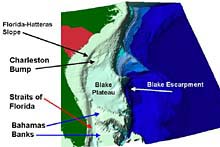
The Charleston Bump lies at the north end of the Blake Plateau, off the coast of South Carolina and Georgia. Click image for larger view.
Investigating the Charleston Bump
August 2 – 16, 2003
Off the coast of South Carolina and Georgia exists a unique feature called the Charleston Bump, which rises off the surrounding Blake Plateau from 2,000 ft deep to a depth of about 1,200 ft. The rocky, erosion-resistant Charleston Bump impedes the flow of the Gulf Stream, deflecting it offshore and creating a zone of gyrating eddies and swift, narrow currents. The combination of rocky, high-relief bottom and strong currents creates a complex habitat consisting of scour depressions, mounds of deep-water corals and rubble, and steep scarps that are deeply undercut with extensive caves.
During this exploration, researchers investigated how fishes and invertebrates adapt to the variety of bottom habitats, and how they tolerate the strong and shifting currents. The investigators also sought new and unique species. Much of the work was conducted using the Johnson-Sea-Link II manned submersible, which was outfitted with digital video, still cameras and other instruments to record information about the surrounding waters. The submersible also collected samples of rocks and sediments, as well as specimens of fishes and invertebrates such as sponges and deep-water corals. Little was known about the creatures that inhabit "the Bump" and the surrounding Blake Plateau, making this a true mission of exploration.
Background information for this exploration can be found on the left side of the page. Daily updates and logs that summarize expedition activities are posted below and to the right.
Updates & Logs
Click images or links below for detailed mission logs.
 Mission Summary The Charleston Bump cruise is complete! Read about the team's experience in the Mission Summary.
Mission Summary The Charleston Bump cruise is complete! Read about the team's experience in the Mission Summary. August 16, 2003 How long will it take for humans to survey the entire ocean floor?
August 16, 2003 How long will it take for humans to survey the entire ocean floor? August 15, 2003 Read about the many symbiotic relationships in the sea.
August 15, 2003 Read about the many symbiotic relationships in the sea. August 14, 2003 Perspectives from students on the cruise.
August 14, 2003 Perspectives from students on the cruise. August 13, 2003 Piecing together a geologic perspective requires first-hand visual interpretation of the seafloor.
August 13, 2003 Piecing together a geologic perspective requires first-hand visual interpretation of the seafloor. August 12, 2003 The crew uses a method over a century old to attract and capture deep sea organisms.
August 12, 2003 The crew uses a method over a century old to attract and capture deep sea organisms. August 11, 2003 How do benthic organisms survive the live-bottom habitat of Charleston Bump? They hide! Read about the Cryptic Life of Benthic Crustaceans.
August 11, 2003 How do benthic organisms survive the live-bottom habitat of Charleston Bump? They hide! Read about the Cryptic Life of Benthic Crustaceans. August 10, 2003 Daily discoveries excite the exploration party and make the wet lab a hub of activity.
August 10, 2003 Daily discoveries excite the exploration party and make the wet lab a hub of activity. August 9, 2003 What is ocean weather, and what does it tell us? Read about it in today's mission log.
August 9, 2003 What is ocean weather, and what does it tell us? Read about it in today's mission log. August 8, 2003 The intricate and complex behavior that has evolved in larvae is a marvel. Read about this behavior in today's log.
August 8, 2003 The intricate and complex behavior that has evolved in larvae is a marvel. Read about this behavior in today's log. August 6, 2003 Back on track, two dives result in rewarding deepwater coral samples.
August 6, 2003 Back on track, two dives result in rewarding deepwater coral samples. August 5, 2003 Complex currents lead to a short stay at 1400 ft.
August 5, 2003 Complex currents lead to a short stay at 1400 ft. August 4, 2003 Daily "disasters" are turned into productive periods through the positive attitudes of all cruise members.
August 4, 2003 Daily "disasters" are turned into productive periods through the positive attitudes of all cruise members. August 3, 2003 A Swordfish takes a swipe at the Johnson Sea Lab II in today's log.
August 3, 2003 A Swordfish takes a swipe at the Johnson Sea Lab II in today's log.

























